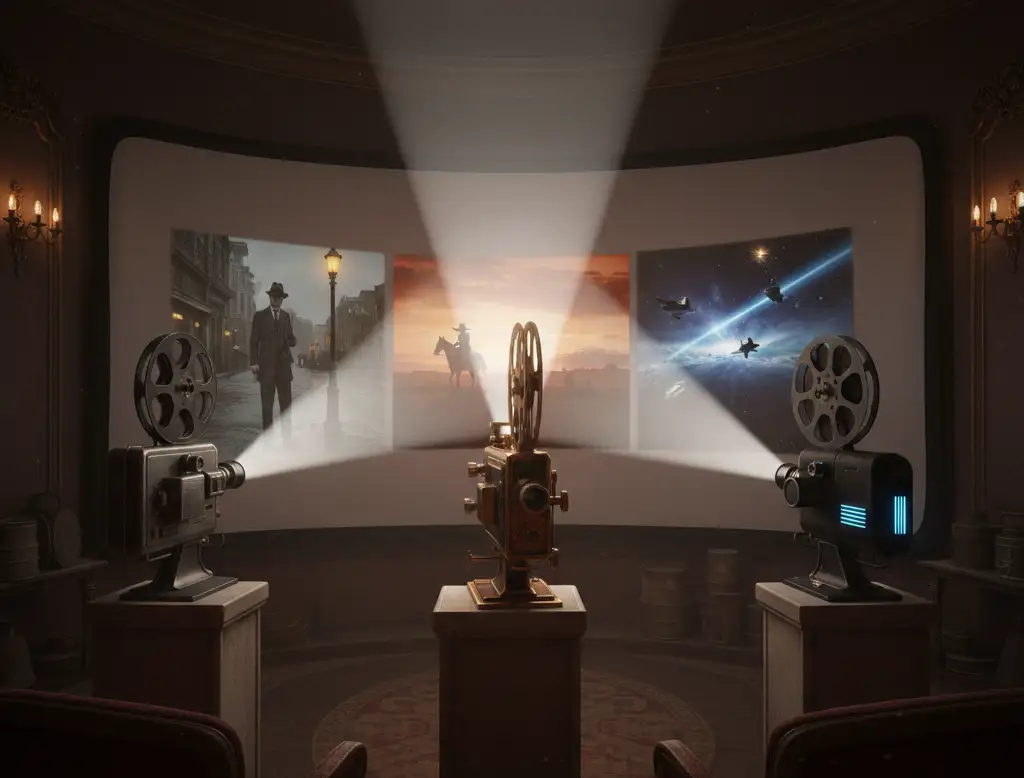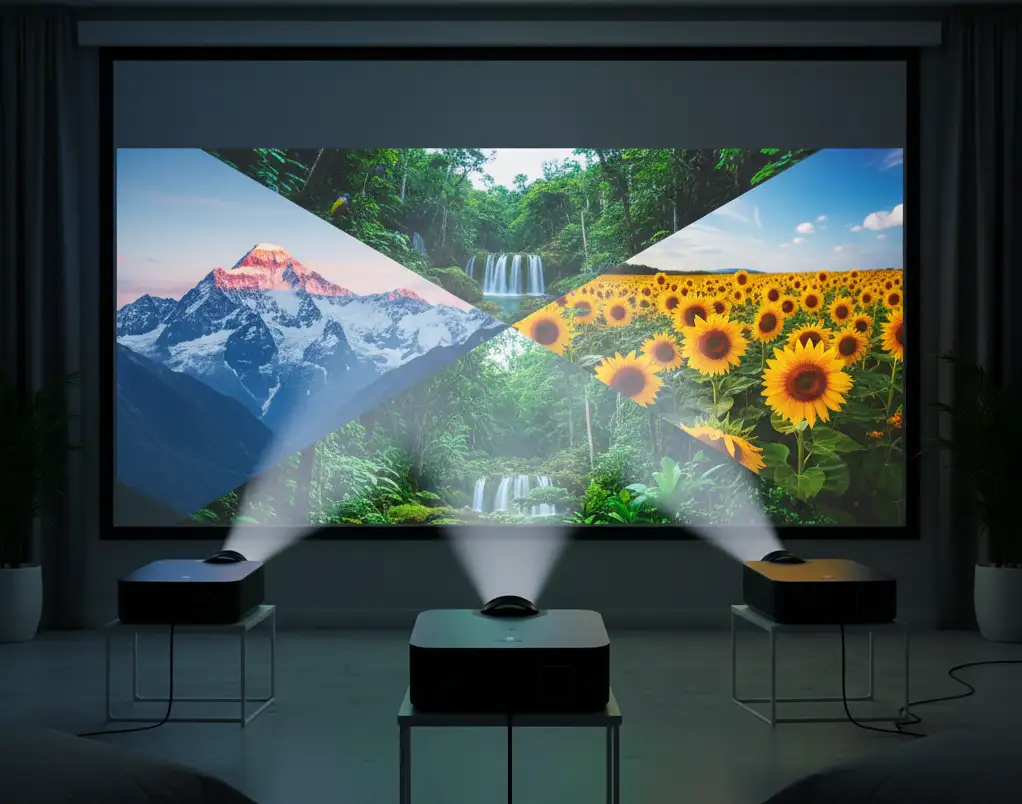Table of Contents
When searching for the perfect projector, understanding the differences between Projector Display LCD vs LED vs DLP is crucial for buyers. Whether the goal is vibrant presentations, cinematic home entertainment, or portable projection solutions, knowing how these technologies stack up on features, quality, and longevity will help users make informed, lasting decisions.
Introduction to Projector Display Types
Projectors have undergone rapid evolution in recent years. Today’s projector market centers around three major technologies:
- LCD (Liquid Crystal Display)
- LED (Light Emitting Diode)
- DLP (Digital Light Processing)
Each technology offers unique strengths and caters to different user profiles. For optimal performance, both technical features and user priorities must be considered in the Projecto Display LCD vs LED vs DLP debate.
How Projector Display LCD vs LED vs DLP Works

LCD Projectors
LCD projectors use three liquid crystal panels (red, green, and blue) to manipulate light and generate images. This method results in bright and vibrant visuals, making LCD the standard in both business and education settings.
LED Projectors
LED projectors utilize LEDs as a light source, driving energy efficiency and ultra-long lamp life. The core technology supporting image processing in LED projectors may be DLP or LCD, but the use of LEDs ensures cool operation and easy portability. LED projectors are popular for portable usage and home entertainment.
DLP Projectors
DLP projectors use a digital micro-mirror device (DMD) with millions of microscopic mirrors that tilt to reflect light through a spinning color wheel. This mechanism produces high contrast ratios, smooth motion, and deeper blacks, which are ideal for movies and gaming. DLP projectors are well-known for their compact design and maintenance-free operation.
In-depth Specifications Comparison: Projector Display LCD vs LED vs DLP Specs
Here’s a detailed side-by-side comparison of projector display specs.
| Feature | LCD Projector | LED Projector | DLP Projector |
|---|---|---|---|
| Technology | Liquid Crystal Display panels | LEDs + either LCD or DLP engine | Digital micro-mirror device + color wheel |
| Brightness (Lumens) | 2500 – 5000+ | 1000 – 4000 | 2000 – 30000+ |
| Contrast Ratio | 500:1 – 5000:1 | 300:1 – 2500:1 | 1000:1 – 30000:1 |
| Resolution Support | 720p – 4K | 720p – 4K | 1080p – 4K+ |
| Lamp Life | 3000 – 6000 hours | 20,000 – 50,000 hours | 3,000 – 30,000 hours |
| Image Quality | Excellent color, sharp text | Good color, softer at high sizes | Strong contrast, smooth motion, vivid blacks |
| Portability | Bulky, heavy | Ultra-compact, lightweight | Generally smaller than LCD, light |
| Maintenance | Needs regular filter replacements | Minimal—almost maintenance-free | Sealed design, minimal maintenance |
| Common Issues | Pixelation, aging panels | Lower brightness in daylight | Rainbow effect (some models) |
| Use Case Fit | Boardroom, classroom, fixed install | Portable, home use, outdoor | Home cinema, gaming, pro AV, theaters |

Image Quality & Color Accuracy
- LCD Projector: Renowned for crisp visuals and true-to-life color reproduction, critical for business and educational purposes.
- LED Projector: Produces pleasant colors but overall brightness may lag behind LCD and DLP.
- DLP Projector: Offers excellent contrast, deeper blacks, and smooth video playback, loved by home theater enthusiasts and gamers.
Brightness & Contrast Ratio
- LCD Projectors shine in well-lit rooms, delivering superior brightness for large spaces.
- LED Projectors perform best in dim environments or at night due to moderate brightness levels.
- DLP Projectors excel in contrast, delivering cinematic viewing experiences with immersive black levels.
Longevity & Maintenance
- LED Projectors: Boast lamp life up to 50,000 hours, requiring almost no maintenance and minimal heat generation.
- LCD Projectors: Offer shorter lamp life (~5,000 hours) with more frequent maintenance due to dust-sensitive internal components.
- DLP Projectors: Have lamp life spanning 3,000–30,000 hours; sealed design results in lower upkeep, but cheaper models may require occasional care.
Portability & Design
- LCD Projectors: Typically larger and heavier, suitable for permanent installations.
- LED Projectors: Ideal for frequent movement—lightweight, small, and perfect for travel or outdoor projection.
- DLP Projectors: Widely adopted for portable and compact projectors; often favored for classrooms, small offices, and home theaters.
Latest Market Data (2025 Specs Table)
Here’s a summary table showcasing actual product specifications from the latest 2025 projector models:
| Brand | Type | Resolution | Brightness (lumens) | Contrast Ratio | Lamp Life | Portability |
|---|---|---|---|---|---|---|
| Epson | LCD | 4K | 2,075 | 5,203:1 | 6,000 hrs | Bulky |
| Zebronics | LED | Full HD | 18,000 | 2,000:1 | 50,000 hrs | Ultra-portable |
| BenQ | DLP | 4K | 1,549 | 1,990:1 | 20,000 hrs | Compact |
| Optoma | DLP | 4K | 1,486 | 1,007:1 | 15,000 hrs | Portable |
Conclusion: Choosing Based on Use Case
Business Presentations & Classrooms
- LCD projectors are unmatched for color accuracy and brightness, making them ideal for clear, vivid presentation displays.
Home Theater & Gaming
- DLP projectors are the gold standard owing to their superior contrast ratio, smooth motion handling, and compact design.
Portable Outdoors & Travel
- LED projectors deliver unbeatable lamp life, extreme portability, and convenient low-maintenance operation, perfect for movie nights under the stars.
Large Venues & Cinematic Screens
- Advanced DLP models (like three-chip systems) dominate in massive screen performance and cinematic visuals.
Bright Environments
- LCD projectors outperform in daylight or brightly lit settings, maintaining visibility and clarity.
Trending FAQ Section
LCD uses liquid crystal panels; LED uses energy-efficient light-emitting diodes; DLP relies on micro-mirrors and a color wheel for projection.
LCD projectors, due to their high brightness output, are best for brightly lit environments.
LED projectors offer lamp life up to 50,000 hours, far longer than either LCD (5,000–6,000 hours) or DLP (up to 30,000 hours).
Yes, their high contrast and smooth motion make DLP projectors ideal for home theaters and gaming.
Some viewers notice brief flashes of rainbow colors due to rapid color wheel movement in single-chip DLP designs.
LED projectors are the lightest and easiest to carry, perfect for travel and outdoor events.
LED and DLP projectors require minimal maintenance, while LCD projectors need regular filter cleaning and may show pixelation over time.
Also Read:

